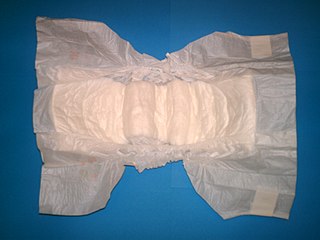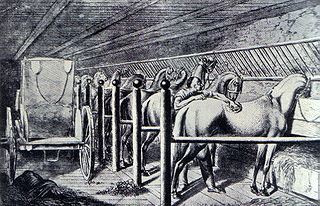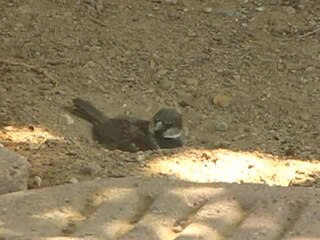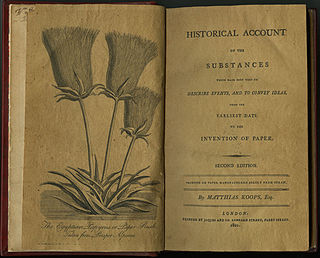
Hay is grass, legumes, or other herbaceous plants that have been cut and dried to be stored for use as animal fodder, either for large grazing animals raised as livestock, such as cattle, horses, goats, and sheep, or for smaller domesticated animals such as rabbits and guinea pigs. Pigs can eat hay, but do not digest it as efficiently as herbivores do.

Straw is an agricultural byproduct consisting of the dry stalks of cereal plants after the grain and chaff have been removed. It makes up about half of the yield by weight of cereal crops such as barley, oats, rice, rye and wheat. It has a number of different uses, including fuel, livestock bedding and fodder, thatching and basket making.

A diaper or a nappy is a type of underwear that allows the wearer to urinate or defecate without using a toilet, by absorbing or containing waste products to prevent soiling of outer clothing or the external environment. When diapers become wet or soiled, they require changing, generally by a second person such as a parent or caregiver. Failure to change a diaper on a sufficiently regular basis can result in skin problems around the area covered by the diaper.

A litter box, also known as a sandbox, cat box, litter tray, cat pan, potty, pot or litter pan, is an indoor feces and urine collection box for cats, as well as rabbits, ferrets, miniature pigs, small dogs, and other pets that instinctively or through training will make use of such a repository. They are provided for pets that are permitted free roam of a home but who cannot or do not always go outside to excrete their metabolic waste.

Sawdust is a by-product or waste product of woodworking operations such as sawing, sanding, milling and routing. It is composed of very small chips of wood. These operations can be performed by woodworking machinery, portable power tools or by use of hand tools. In some manufacturing industries it can be a significant fire hazard and source of occupational dust exposure.

A corncob also called corn cob or cob of corn, is the hard core of an ear of maize, bearing the kernels, made up of the chaff, woody ring, and pith. Corncobs contain mainly cellulose, hemicellulose, and lignin.

An animal stall is an enclosure housing one or a few animals. Stalls for animals can often be found wherever animals are kept: a horse stable is often a purpose-built and permanent structure. A farmer's barn may be subdivided into animal stalls or pens for cows and other livestock.
Corn construction refers to the use of corn (maize) in construction. The tassel, leaf, silk, cob in husks, and the stalk are the parts of corn. According to the Michigan Department of Agriculture, "corn can be made into fuel, abrasives, solvents, charcoal, animal feed, bedding for animals, insulation, adhesives, and more. The kernel is used as oil, bran, starch, glutamates, animal feed, and solvents. The silk is combined with other parts of the corn plant to be used as part of animal feed, silage, and fuels. Husks are made into dolls and used as filling materials. The stalk is used to make paper, wallboard, silage, syrup, and rayon ."

In agriculture, poultry litter or broiler litter is a mixture of poultry excreta, spilled feed, feathers, and material used as bedding in poultry operations. This term is also used to refer to unused bedding materials. Poultry litter is used in confinement buildings used for raising broilers, turkeys and other birds. Common bedding materials include wood shavings, sawdust, peanut hulls, shredded sugar cane, straw, and other dry, absorbent, low-cost organic materials. Sand is also occasionally used as bedding. The bedding materials help absorb moisture, limiting the production of ammonia and harmful pathogens. The materials used for bedding can also have a significant impact on carcass quality and bird performance.
Recurrent airway obstruction, also known as broken wind, heaves, wind-broke horse, or sometimes by the term usually reserved for humans, chronic obstructive pulmonary disease or disorder (COPD) – it is a respiratory disease or chronic condition of horses involving an allergic bronchitis characterised by wheezing, coughing and laboured breathing.

Swarf, also known as chips or by other process-specific names, are pieces of metal, wood, or plastic that are the debris or waste resulting from machining, woodworking, or similar subtractive (material-removing) manufacturing processes. Swarf can be small particles ; long, stringy tendrils ; slag-like waste ; or stone fragments and dust.

Brown waste is any biodegradable waste that is predominantly carbon based. The term includes such items as grass cuttings, dry leaves, twigs, hay, paper, sawdust, corn cobs, used livestock bedding, manure, animal waste, cardboard, pine needles or cones, etc. Carbon is necessary for composting, which uses a combination of green waste and brown waste to promote the microbial processes involved in the decomposition process. The composting of brown waste sustainably returns the carbon to the carbon cycle.
Hay steaming is a method of treating hay to reduce the airborne respirable dust which naturally occurs in hay, causing respiratory problems in both humans and horses when in close contact. The method encompasses a steam generator which produces the steam and a connecting hose to direct the steam into a closed, sealed vessel containing the hay, exposing it to the steam.

Dust bathing is an animal behavior characterized by rolling or moving around in dust, dry earth or sand, with the likely purpose of removing parasites from fur, feathers or skin. Dust bathing is a maintenance behavior performed by a wide range of mammalian and avian species. For some animals, dust baths are necessary to maintain healthy feathers, skin, or fur, similar to bathing in water or wallowing in mud. In some mammals, dust bathing may be a way of transmitting chemical signals to the ground which marks an individual's territory.
Alternative natural materials are natural materials like rock or adobe that are not as commonly used as materials such as wood or iron. Alternative natural materials have many practical uses in areas such as sustainable architecture and engineering. The main purpose of using such materials is to minimize the negative effects that built environments can have on the planet, while increasing the efficiency and adaptability of the structures.

Manure is organic matter that is used as organic fertilizer in agriculture. Most manure consists of animal feces; other sources include compost and green manure. Manures contribute to the fertility of soil by adding organic matter and nutrients, such as nitrogen, that are utilised by bacteria, fungi and other organisms in the soil. Higher organisms then feed on the fungi and bacteria in a chain of life that comprises the soil food web.

Matthias Koops was a British paper-maker who invented the first practical processes for manufacturing paper from wood pulp, straw, or recycled waste paper, without the necessity of including expensive linen or cotton rags.

A hamster cage is an enclosure designed to house one hamster. It is recommended that hamster cages are at least 5000cm² for dwarf hamster except Roborovski and 6000cm² for syrian and Roborovski, although there is evidence that hamsters experience less stress if housed in larger cages. Commercially available pens are made of wire or plastic - both of which are unsafe for hamsters. Some pet owners house their hamsters in aquarium tanks, and some make their own pens out of wood or safe materials like plexi. Laboratory hamsters, commonly known as laboratory Syrian hamsters, are housed in pens designed for scientific use. There are also special pens designed for hamster shows.
A compost bedded pack barn (CBP) is a type of housing for dairy cattle. It is a loose housing system, similar to free-stall housing, except there are no stalls or partitions.

Any type of woodworking that involves cutting, either by hand or machine, releases sawdust. Because fine sawdust can float through the air, it can be easily inhaled without proper protection, leading to damaging injuries to a woodworker's skin and lungs. Sawdust is also an IARC group 1 Carcinogen.















